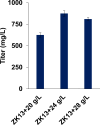Microbial production of 5- epi-jinkoheremol, a plant-derived antifungal sesquiterpene
- PMID: 39283105
- PMCID: PMC11497823
- DOI: 10.1128/aem.01191-24
Microbial production of 5- epi-jinkoheremol, a plant-derived antifungal sesquiterpene
Abstract
Synthetic biology using microbial chassis is emerging as a powerful tool for the production of natural chemicals. In the present study, we constructed a microbial platform for the high-level production of a sesquiterpene from Catharanthus roseus, 5-epi-jinkoheremol, which exhibits strong fungicidal activity. First, the mevalonate and sterol biosynthesis pathways were optimized in engineered yeast to increase the metabolic flux toward the biosynthesis of the precursor farnesyl pyrophosphate. Then, the transcription factor Hac1- and m6A writer Ime4-based metabolic engineering strategies were implemented in yeast to increase 5-epi-jinkoheremol production further. Next, protein engineering was performed to improve the catalytic activity and enhance the stability of the 5-epi-jinkoheremol synthase TPS18, resulting in the variant TPS18I21P/T414S, with the most improved properties. Finally, the titer of 5-epi-jinkoheremol was elevated to 875.25 mg/L in a carbon source-optimized medium in shake flask cultivation. To the best of our knowledge, this is the first study to construct an efficient microbial cell factory for the sustainable production of this antifungal sesquiterpene.IMPORTANCEBiofungicides represent a new and sustainable tool for the control of crop fungal diseases. However, hindered by the high cost of biofungicide production, their use is not as popular as expected. Synthetic biology using microbial chassis is emerging as a powerful tool for the production of natural chemicals. We previously identified a promising sesquiterpenoid biofungicide, 5-epi-jinkoheremol. Here, we constructed a microbial platform for the high-level production of this chemical. The metabolic engineering of the terpene biosynthetic pathway was firstly employed to increase the metabolic flux toward 5-epi-jinkoheremol production. However, the limited catalytic activity of the key enzyme, TPS18, restricted the further yield of 5-epi-jinkoheremol. By using protein engineering, we improved its catalytic efficiency, and combined with the optimization of regulation factors, the highest production of 5-epi-jinkoheremol was achieved. Our work was useful for the larger-scale efficient production of this antifungal sesquiterpene.
Keywords: 5-epi-jinkoheremol; Saccharomyces cerevisiae; antifungal sesquiterpene; metabolic engineering; protein engineering.
Conflict of interest statement
The authors declare no conflict of interest.
Figures





Similar articles
-
Significantly Enhanced Production of Patchoulol in Metabolically Engineered Saccharomyces cerevisiae.J Agric Food Chem. 2019 Aug 7;67(31):8590-8598. doi: 10.1021/acs.jafc.9b03456. Epub 2019 Jul 26. J Agric Food Chem. 2019. PMID: 31287301
-
A squalene synthase protein degradation method for improved sesquiterpene production in Saccharomyces cerevisiae.Metab Eng. 2017 Jan;39:209-219. doi: 10.1016/j.ymben.2016.12.003. Epub 2016 Dec 8. Metab Eng. 2017. PMID: 27939849
-
Combined metabolic engineering of precursor and co-factor supply to increase α-santalene production by Saccharomyces cerevisiae.Microb Cell Fact. 2012 Aug 31;11:117. doi: 10.1186/1475-2859-11-117. Microb Cell Fact. 2012. PMID: 22938570 Free PMC article.
-
Metabolic engineering strategies for sesquiterpene production in microorganism.Crit Rev Biotechnol. 2022 Feb;42(1):73-92. doi: 10.1080/07388551.2021.1924112. Epub 2021 Jul 13. Crit Rev Biotechnol. 2022. PMID: 34256675 Review.
-
Heterologous Biosynthesis of Terpenoids in Saccharomyces cerevisiae.Biotechnol J. 2025 Jan;20(1):e202400712. doi: 10.1002/biot.202400712. Biotechnol J. 2025. PMID: 39834096 Review.
Cited by
-
Overexpression of tRNA m7G modification methyltransferase complex promotes the biosynthesis of triterpene in yeast.Front Microbiol. 2025 Mar 31;16:1557443. doi: 10.3389/fmicb.2025.1557443. eCollection 2025. Front Microbiol. 2025. PMID: 40231236 Free PMC article.
References
-
- Tang FHM, Lenzen M, McBratney A, Maggi F. 2021. Risk of pesticide pollution at the global scale. Nat Geosci 14:206–210. doi:10.1038/s41561-021-00712-5 - DOI
MeSH terms
Substances
Grants and funding
LinkOut - more resources
Full Text Sources

